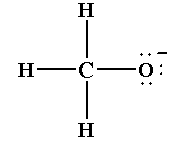
Answer
425.1k+ views
Hint: The methoxide ion $C{H_3}{O^ - }$ is an anion formed by gaining one electron where the negative charge is localized at the oxygen atom. In the structure no double bond is seen. When the structure is not explained by one Lewis structure, then the resonance effect is seen.
Complete step by step answer:
Lewis structure is defined as a representation of the valence electrons around the atoms of the molecule. The Lewis structure of the compound is used to show how the electrons are placed around the atoms of the compounds. The valence electrons are shown as small dots.
When any ion or compound is not explained by one Lewis structure, two or more sets of Lewis structure are formed and this is known as resonance effect.
The resonance effect is defined as the sets of Lewis structure which describes the delocalization of electrons in a molecule.
The methoxide is an organic anion which behaves as the conjugate base of methanol. The chemical formula of methoxide ion is $C{H_3}{O^ - }$.
The Lewis structure of methoxide ion is shown below.

The negative charge of the anion is localized at the oxygen atom of the methoxide ion.
The structure of methoxide ion can be explained by one Lewis structure. So, no resonance structure is formed for methoxide ion $C{H_3}{O^ - }$.
Note:
The Lewis structure does not explain the geometry of the molecules, how the bonds are formed or how the valence electrons are shared between the atoms of the compound. The methoxide ion is a stronger base than hydroxide ions. It acts as a nucleophile.
Complete step by step answer:
Lewis structure is defined as a representation of the valence electrons around the atoms of the molecule. The Lewis structure of the compound is used to show how the electrons are placed around the atoms of the compounds. The valence electrons are shown as small dots.
When any ion or compound is not explained by one Lewis structure, two or more sets of Lewis structure are formed and this is known as resonance effect.
The resonance effect is defined as the sets of Lewis structure which describes the delocalization of electrons in a molecule.
The methoxide is an organic anion which behaves as the conjugate base of methanol. The chemical formula of methoxide ion is $C{H_3}{O^ - }$.
The Lewis structure of methoxide ion is shown below.

The negative charge of the anion is localized at the oxygen atom of the methoxide ion.
The structure of methoxide ion can be explained by one Lewis structure. So, no resonance structure is formed for methoxide ion $C{H_3}{O^ - }$.
Note:
The Lewis structure does not explain the geometry of the molecules, how the bonds are formed or how the valence electrons are shared between the atoms of the compound. The methoxide ion is a stronger base than hydroxide ions. It acts as a nucleophile.
Recently Updated Pages
Identify the feminine gender noun from the given sentence class 10 english CBSE

Your club organized a blood donation camp in your city class 10 english CBSE

Choose the correct meaning of the idiomphrase from class 10 english CBSE

Identify the neuter gender noun from the given sentence class 10 english CBSE

Choose the word which best expresses the meaning of class 10 english CBSE

Choose the word which is closest to the opposite in class 10 english CBSE

Trending doubts
Sound waves travel faster in air than in water True class 12 physics CBSE

A rainbow has circular shape because A The earth is class 11 physics CBSE

Which are the Top 10 Largest Countries of the World?

Fill the blanks with the suitable prepositions 1 The class 9 english CBSE

One Metric ton is equal to kg A 10000 B 1000 C 100 class 11 physics CBSE

How do you graph the function fx 4x class 9 maths CBSE

The Equation xxx + 2 is Satisfied when x is Equal to Class 10 Maths

Give 10 examples for herbs , shrubs , climbers , creepers

Change the following sentences into negative and interrogative class 10 english CBSE




